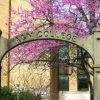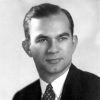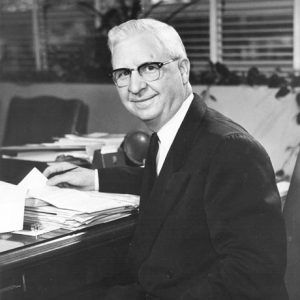calsfoundation@cals.org
National Education Program
The National Education Program (NEP) was founded by Harding College (now Harding University) president George S. Benson to disseminate his ideas on Americanism. These included three fundamental principles: belief in God, belief in the U.S. Constitution, and belief in the free-enterprise system. Sources disagree about the date the NEP was founded, citing 1936, 1941, and 1948. The NEP wedded fundamentalist Christian religion with free-enterprise economic thought, which became foundational to the conservative movement that gained prominence with the election of Ronald Reagan in 1980.
A native Oklahoman and a member of the Church of Christ, Benson completed his bachelor’s degree at Harding College and afterward served as principal of its high school division. In 1925, he and his wife, Sallie Ellis Hockaday Benson, began a decade-long sojourn in China as missionaries. The war between Nationalist and Communist forces there brought the perceived threat of communism to America to his attention. Especially alarming to him was stateside news in the form of a committee report from the National Education Association’s 1934 national convention. According to Benson, the report called for the complete destruction of “a dying laissez faire [do-nothingism]” in order to subject all Americans, especially property owners, to “a large degree of social control.” Benson stated that the report proclaimed that “distinguished students” would help create a “swift nationwide campaign of adult education” to assist President Franklin D. Roosevelt in taking control of banks, industries, and utilities. Fearing a communist takeover in the United States, Benson decided to devote his life to fighting what he saw as a threat to the American way of life.
In 1936, Benson returned to America to become president of Harding College. As the college was deeply in debt, he began a campaign of soliciting donations from businessmen, especially those belonging to the Churches of Christ. By Thanksgiving Day in 1939, the debt of $80,000 was paid in full, allowing him to focus on his crusade for his brand of Americanism.
Among the contacts he had made was Clinton Davidson, a wealthy insurance salesman with clients in New York. Davidson introduced Benson to business moguls, including presidents of major oil and steel companies and corporations such as DuPont Chemical and Quaker Oats. Davidson’s contacts with Washington DC lobbyists resulted in Benson appearing before the U.S. House Ways and Means Committee on May 15, 1941, to testify against a tax increase intended to fund a buildup of America’s military. Instead of new taxes, Benson advocated the elimination of New Deal programs, including the Works Progress Administration (WPA), the Civilian Conservation Corps (CCC), and the National Youth Administration (NYA). The money saved, he argued, could be used to fund military expenditures. Garnering nationwide attention, the speech was reprinted in newspapers including the New York Times and the Chicago Journal of Commerce.
Overnight, Benson became a national sensation, resulting in numerous opportunities to promote his program. In 1949, he addressed 186 audiences totaling 73,170 people in thirty-two states. In 1942, he received time free of charge for his speeches on two radio stations, KLRA in Little Rock (Pulaski County) and WMC in Memphis, Tennessee. In the 1950s, his radio program, “Land of the Free,” was broadcast on more than 300 stations. Also in 1942, he began writing a weekly newspaper column, “Looking Ahead,” which was syndicated in more than 4,000 publications in the 1950s.
Initially, the Americanism program was conducted through the college’s Department of Education. By the late 1940s, it officially received the name “Harding College National Education Program.” It coordinated speaking engagements and produced materials including reprints of Benson’s speeches and newspaper columns as well as original writings, films, filmstrips, and audio recordings of programs. Receiving a nationwide distribution, these materials were used by the U.S. armed forces, public schools, colleges and universities, chapters of the American Legion, and local chambers of commerce. Benson made a deal with MGM studios that resulted in NEP-produced short films, including cartoons made by former Walt Disney employees, being shown in 15,000 theaters nationwide. NEP materials attracted special interest from heads of corporations desiring to quell laborers they characterized as restless. Required to attend NEP-sponsored seminars, workers commonly received copies of Benson’s lectures with their paychecks.
From its inception, the program maintained an ambiguous relationship with the college. Benson was president of both the NEP and Harding College. The boards of the two entities had identical membership. Besides Benson, Harding officials involved with the NEP included history professor Clifton L. Ganus, who served as a lecturer, and religion professor James D. Bales, who worked as the program’s primary researcher and writer. The NEP generated enormous revenue in the form of donations to Harding; these included large donations from Boeing Aircraft and Gulf Oil to the college. In 1952, the Arkansas Gazette revealed that such donations allowed the college to build nine buildings, including a library, an administration building, two dormitories, and two auditoriums.
In 1948, representatives of the Association of National Advertisers and the American Association of Advertising Agencies proposed to Benson the creation of a nationwide seminar to discuss “basic internal problems” facing America. As a result, in 1949, the NEP hosted its first Freedom Forum. Speakers included Nobel laureate and physicist Robert Millikan of the California Institute of Technology; T. C. Kirkpatrick, a former agent with the Federal Bureau of Investigation (FBI) and editor of the anticommunist journal Counterattack; and representatives of Harding College, including Benson, Ganus, and Bales. The success of the event made the Freedom Forum an NEP mainstay. In 1950, an NEP source reported that “Forum alumni” were “crusading” in forty-eight states, with forums being presented every three months. According to the Harding College Bison, a student newspaper, about 3,600 executives from more than 1,000 companies and other organizations attended forums during the period from 1949 to 1965. Speakers included representatives of Quaker Oats, General Motors, Arkansas Power and Light, Republic Steel, Pepsi-Cola, General Electric, Kellogg Foods, and the U.S. Chamber of Commerce. Arkansas politicians speaking at the forums included Governor Orval Faubus, Senator John L. McClellan, and Congressman Wilbur Mills.
In the early 1950s, however, the relationship between Harding and the NEP became increasingly problematic. Housed on the campus of Harding, the NEP was closely intertwined with the college’s American studies program, which used NEP speakers and literature. This relationship prevented Harding from receiving accreditation until 1954, when the NEP was incorporated as an entity separate from the college. Dropping “Harding College” from its name, it nevertheless remained on campus, with Benson, Ganus, and Bales all continuing their involvement while the NEP board essentially had the same members as the college’s board.
By 1954, the NEP offered its services in fifteen different locations, sponsoring summer classes for teachers and week-long training sessions for high school students. In 1957, Benson became chancellor of Oklahoma Christian College (OCC), a post he occupied in addition to being president of both Harding and the NEP. At OCC, he founded the American Citizenship Training Center. It conducted its own Freedom Forums and youth seminars, utilizing NEP materials and speakers.
Throughout the 1950s, Benson and the NEP received considerable praise from the public and the press, with Benson being selected the Arkansan Man of the Year by Arkansas Democrat readers in 1953. But in the early 1960s, Benson and the NEP became focal points of controversy. In May 1960, the NEP issued a filmstrip titled “Communism on the Map.” Narrated by General George C. Marshall, it purported to show that communists and communist-sympathizers had almost gained control over the entire world. In response, American socialist leader Norman Thomas in April 1961 denounced “Communism on the Map” as paranoid. A viewing of the filmstrip resulted in ninety-two faculty members at the University of Washington labeling it an “irresponsible mingling of fact and falsehood.” Benson dismissed the criticism as efforts by “socialist[s]” and their “fellow traveler[s]” to discredit the filmstrip.
The most devastating critique of Benson and the NEP came from Senator J. William Fulbright of Arkansas in the form of the “Fulbright Memorandum” to Secretary of Defense Robert McNamara in June 1961. The memorandum mentioned by name Benson; Clifton L. Ganus Jr., who had become vice president of Harding and dean of its American studies program; and John Birch Society–affiliated film producer Glenn Green, who was executive vice president of the NEP. The memorandum also drew attention to the activities of Fred C. Schwartz of the Christian Anti-Communism Crusade, a Benson protégé and a frequent speaker at Freedom Forums. In particular, the memorandum expressed alarm at the use of NEP speakers and materials in the indoctrination of members of the United States military.
In 1964, the NEP was included in the Anti-Defamation League of B’Nai B’Rith’s book Danger on the Right by Arnold Forster and Benjamin R. Epstein. They charged that the NEP was one of several “Radical Right” organizations undermining American democracy. Bales responded with the book Americanism under Fire (1965), an apologetic for Benson and the NEP.
In 1964, the NEP supported the candidacy of Republican U.S. presidential candidate Barry Goldwater. The following year, Benson retired from Harding College but remained on the college’s board and continued to serve as president of the NEP. Ganus succeeded him as school president. In 1969, Harding College English professor James L. Atteberry was forced to resign after receiving severe criticism from Bales for remarks he made regarding intellectual freedom. Several faculty members resigned in protest, and articles appeared in Church of Christ publications revealing the rough treatment of Atteberry and the NEP’s political activities on the Harding campus. Many students resented the manner in which the NEP tainted Harding’s reputation as an academic institution. The NEP also became the subject of criticism from members of the Church of Christ concerned about church involvement in politics.
After 1970, the history of the NEP is obscure. Aging donors began to die out, severely reducing the organization’s revenues. Eventually, the program relocated to the campus of Oklahoma Christian College. In 1982, Enterprise Square USA opened on the OCC campus, billed as the culmination of the work of the NEP and the American Citizenship Training Center. The Square provided state-of-the-art facilities to promote its version of Americanism. Benson made his last “Behind the News” radio broadcast in April 1984. As late as 1990, the NEP’s mailing list included 23,000 names. By 1990, Bob Rowland, president of the American Citizenship Training Center and executive director of Enterprise Square USA, had succeeded Benson as president of the NEP.
The ultimate fate of the NEP remains unclear. However, the McGaw Endowment, created in the late 1970s from the estate of Mary and Foster McGaw of Evanston, Illinois, to fund NEP activities, continues to support lecturers, seminars, and events on the Oklahoma Christian University campus in the twenty-first century.
Historian L. Edward Hicks argues that the NEP’s greatest legacy lies in its influence on Ronald Reagan and the conservative movement. In 1962, Reagan narrated an NEP film, The Truth About Communism. Along with Reagan, Jerry Falwell, and Pat Robertson, Benson spoke at a pro-Republican Moral Majority rally in August 1980. According to Hicks, the election of Ronald Reagan as president of the United States marked the culmination of the NEP’s efforts to promote its program of Americanism.
For additional information:
77th Cong., 1st sess., Congressional Record 87, pt. 11 (May 15, 1941): A 2325–2328.
Arkansas Archives of Public Communication. Special Collections. University of Arkansas Libraries, Fayetteville, Arkansas.
Atteberry, James. “The Freedom of Scholarship.” Mission 2 (October 1969): 104–109.
Baily, Brianna. “Oklahoma Pro-Capitalism Museum Met Ironic End.” The Oklahoman, October 26, 2014. Online at http://newsok.com/article/5360248 (accessed July 26, 2017).
Bales, James D. Americanism under Fire. Searcy, AR: Bales Bookstore, 1965.
Benson, George S. “The Leopard’s ‘Free’ Lunch.” Searcy, AR: The National Education Program, 1950.
Epstein, Benjamin R., and Arnold Forster. Danger on the Right: The Attitudes, Personnel, and Influence of the Radical Right and Extreme Conservatives. New York: Random House, 1964.
Expanding American Markets: Freedom Forum XXV. Searcy, AR: The National Education Program, 1964.
Fletcher, John L. “George S. Benson—His Fight: Free Enterprise.” Arkansas Gazette, December 14, 1952, p. 6F.
Garner, Donald P. “George S. Benson: Conservative, Anti-Communist, Pro-Americanism Speaker.” PhD diss., Wayne State University, 1963.
Hicks, L. Edward. “A Case Study of Conservative Political Education: Dr. George S. Benson and the National Education Program.” PhD diss., Memphis State University, 1990.
———. “Sometimes in the Wrong, but Never in Doubt”: George S. Benson and the Education of the New Religious Right. Knoxville: University of Tennessee Press, 1994.
James D. Bales Papers. Special Collections. University of Arkansas Libraries, Fayetteville, Arkansas.
Lynch, Dudley. “Harding and the Atteberry Case.” Christian Chronicle 26 (June 9, 1969): 1–2.
———. “The Politics of Harding.” Mission 3 (April 1970): 305–311.
Money, Royce Lynn. “Church-State Relations in the Churches of Christ since 1945: A Study in Religion and Politics.” PhD diss., Baylor University, 1975.
“The National Education Program Announces: The One Day Freedom Forum for Every American Community: Catalog American Citizenship Education Materials.” Searcy, AR: The National Education Program, ca. 1961.
Todd E. Lewis
University of Arkansas, Fayetteville




 George Stuart Benson
George Stuart Benson 



Comments
No comments on this entry yet.